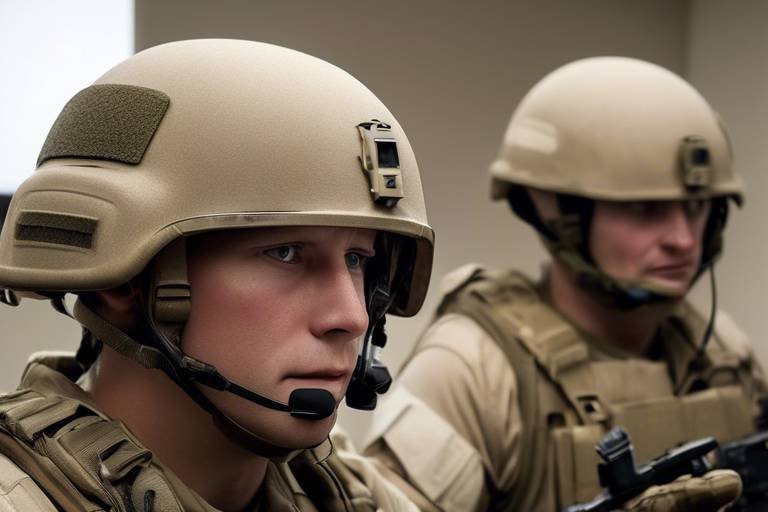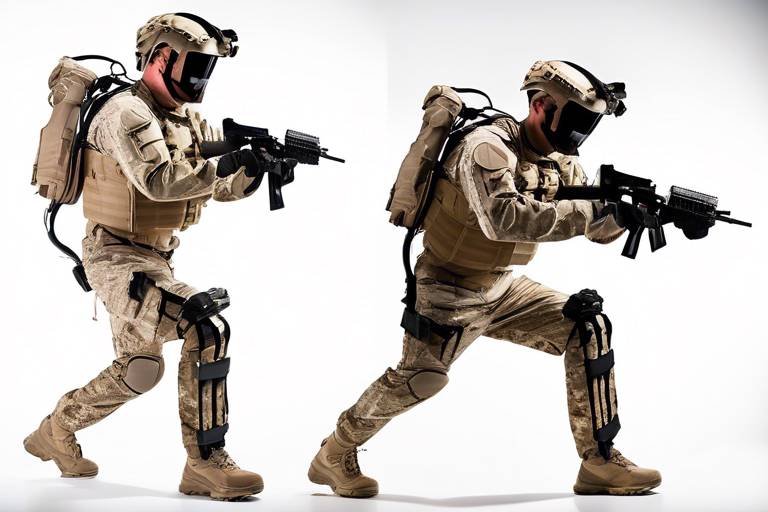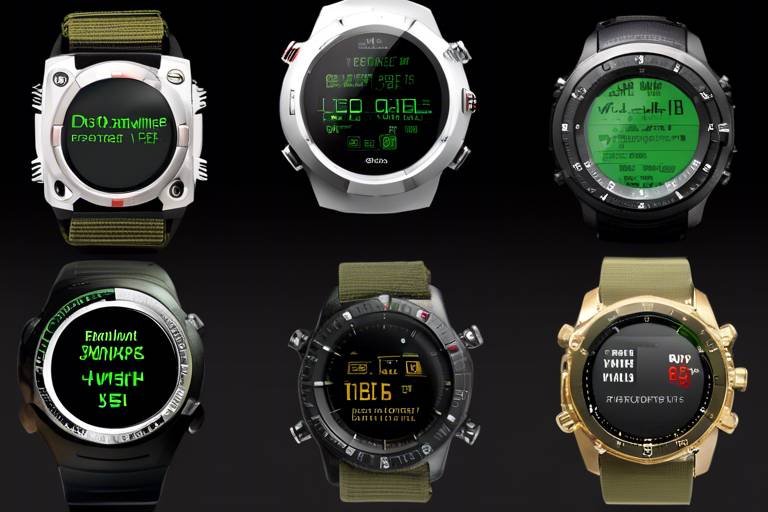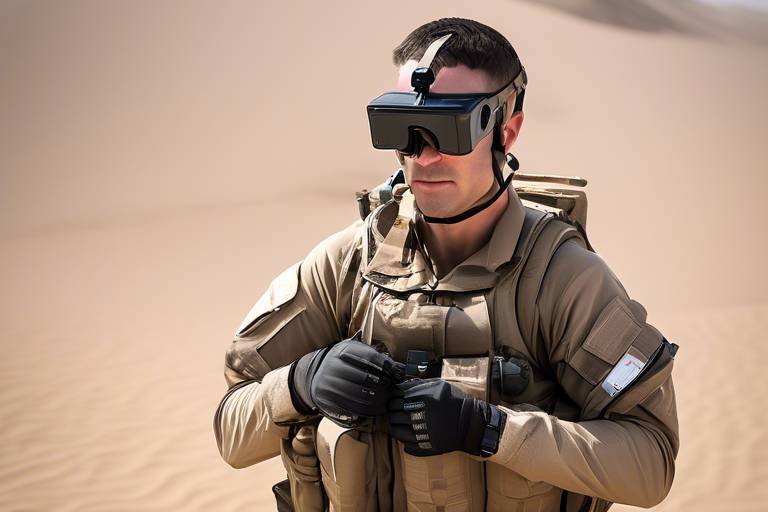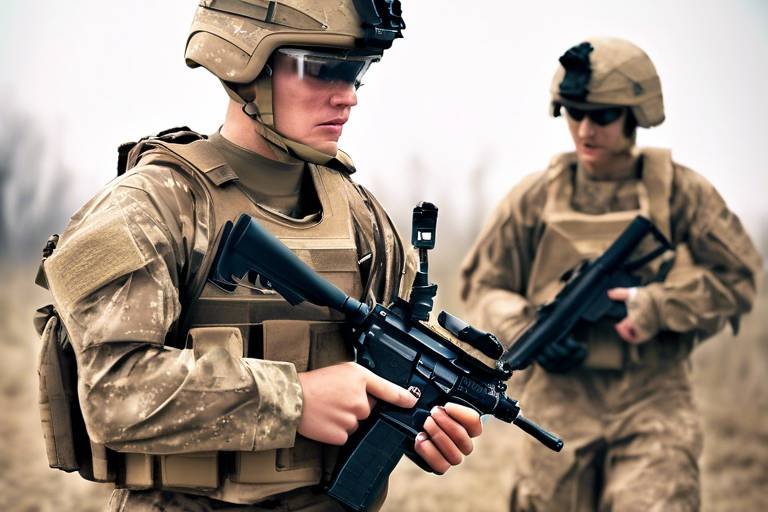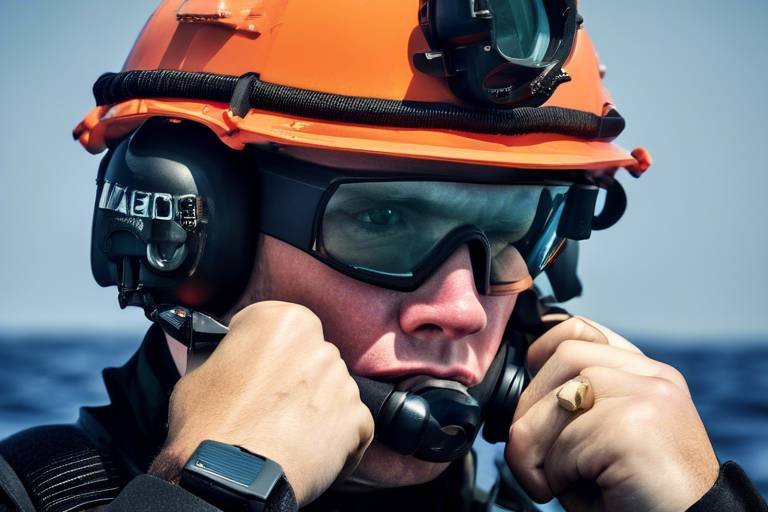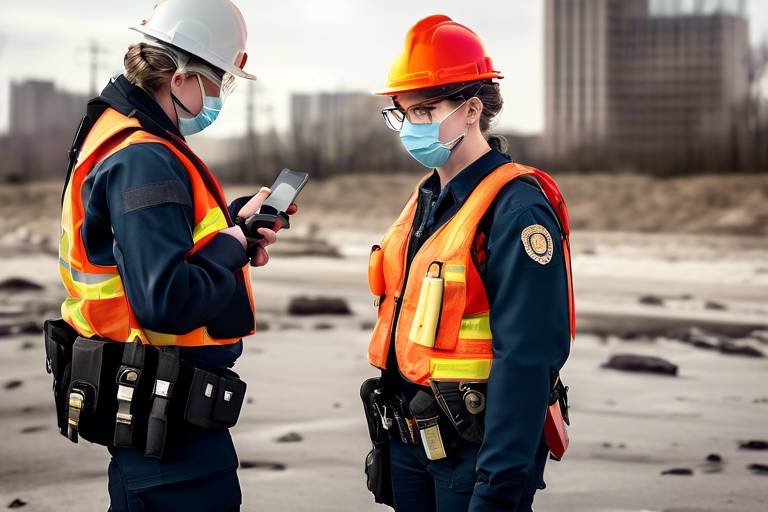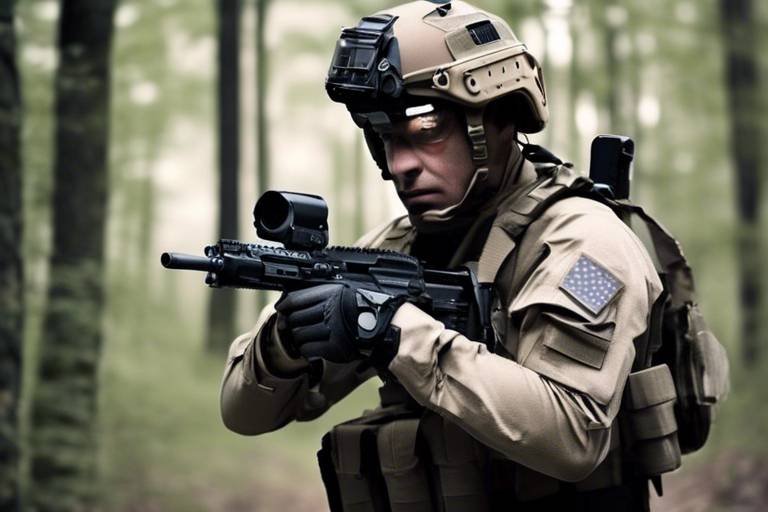How Smart Helmets Improve Communication in Combat
In the fast-paced world of modern warfare, communication can mean the difference between life and death. Smart helmets have emerged as a revolutionary tool for military personnel, providing advanced features that enhance communication and situational awareness on the battlefield. Imagine a soldier equipped with a helmet that not only protects but also connects them seamlessly to their team, relaying critical information in real-time. This is not just science fiction; it’s the reality of today’s combat technology. As we explore the transformative role of smart helmets, we'll uncover how they integrate cutting-edge technology to improve operational efficiency, safety, and overall mission success.
One of the most significant advancements in smart helmets is the incorporation of enhanced communication systems. These systems allow for real-time voice and data exchange among soldiers, which is crucial during combat operations. Picture a unit moving through hostile territory; with smart helmets, they can communicate instantly without the need for hand signals or cumbersome radios. This real-time communication not only improves coordination but also drastically reduces response times. For instance, when a soldier spots an enemy position, they can alert their team immediately, ensuring everyone is on the same page and ready to act. This level of connectivity fosters a sense of unity and enhances the overall effectiveness of military operations.
Another groundbreaking feature of smart helmets is the integration of augmented reality (AR). This technology overlays critical information directly into the soldier's field of vision, providing them with essential data without diverting their attention from their surroundings. Imagine being in a combat zone and having access to maps, troop locations, and threat indicators all displayed in your line of sight. This augmented reality capability enhances situational awareness, allowing soldiers to make informed decisions quickly, even in high-pressure environments. The ability to visualize data as it unfolds can be likened to having a personal assistant in the chaos of battle, guiding and informing every step of the way.
The ability to share real-time data through smart helmets is a game-changer for military teams. This feature ensures that all members are aware of changing conditions and potential threats, maintaining a tactical advantage. For example, if one soldier encounters an unexpected obstacle, they can instantly share this information with their team, allowing for quick adjustments to their strategy. This level of connectivity not only enhances teamwork but also builds trust among soldiers, knowing that they can rely on each other for up-to-the-minute information.
Smart helmets also come equipped with GPS integration, allowing for precise location tracking. This feature is invaluable for commanders who need to monitor troop movements and coordinate efforts effectively during missions. By having real-time visibility of where each soldier is located, commanders can make swift decisions, redirecting forces as necessary to respond to evolving battlefield dynamics. This capability is akin to having a live map that updates every second, ensuring that no soldier is left behind.
In addition to communication and navigation, smart helmets can monitor environmental conditions. They can alert soldiers to hazards such as toxic gas or extreme weather changes, significantly enhancing safety on the battlefield. This feature acts like an early warning system, allowing soldiers to take necessary precautions before they are exposed to potentially life-threatening situations. The ability to be aware of one’s environment is crucial, especially in unpredictable combat scenarios.
Beyond combat, smart helmets are revolutionizing training and simulation for military personnel. They provide immersive experiences that prepare soldiers for real-life combat situations while improving their communication skills. During training exercises, soldiers can practice their responses to various scenarios, receiving immediate feedback through their smart helmets. This hands-on approach not only enhances their tactical skills but also builds confidence, ensuring they are ready for anything when it counts.
When it comes to combat, safety is paramount. Smart helmets are designed with advanced safety features such as impact sensors and emergency communication systems. These innovations protect soldiers and ensure swift assistance when needed. For instance, if a soldier suffers a blow to the head, the helmet can automatically alert medics and command centers, streamlining the response process. This capability can be likened to having a safety net, ready to catch you in times of crisis.
In emergencies, the quick response of smart helmets can mean the difference between life and death. Their built-in crisis response mechanisms can automatically alert medics and command centers, ensuring that help is on the way before a soldier even has to make a call for assistance. This rapid intervention can potentially save lives, highlighting the importance of technology in modern warfare.
Smart helmets are built to last, designed for extreme conditions to ensure that communication systems remain functional and reliable during critical missions. They can withstand harsh environments, making them a crucial piece of equipment for soldiers in the field. Just like a trusty old pair of boots, these helmets provide the durability and reliability that soldiers need to focus on their mission without worrying about their gear.
As technology continues to advance, the future of smart helmets promises even more innovations. We can expect enhanced AI capabilities and improved integration with other military systems. This evolution will further revolutionize combat communication, making operations more efficient and effective. Imagine a future where helmets can analyze data and provide predictive insights, allowing soldiers to stay one step ahead of their adversaries.
- What are smart helmets? Smart helmets are advanced headgear equipped with communication systems, augmented reality, and safety features designed to enhance military operations.
- How do smart helmets improve communication in combat? They facilitate real-time voice and data exchange among soldiers, improving coordination and reducing response times.
- What safety features do smart helmets have? They include impact sensors, environmental monitoring, and emergency communication systems to protect soldiers.
- Will smart helmets evolve in the future? Yes, advancements in technology will likely lead to enhanced AI capabilities and better integration with military systems.
Enhanced Communication Systems
In the high-stakes world of combat, effective communication can mean the difference between success and failure. Smart helmets have revolutionized the way soldiers communicate on the battlefield, integrating advanced technologies that facilitate seamless interaction. Imagine a soldier in the heat of battle, equipped with a helmet that allows them to talk to their squad without the need for traditional radios or hand signals. This is not science fiction; it’s the reality of modern warfare.
These helmets are designed with real-time voice and data exchange capabilities, allowing soldiers to share critical information instantly. This level of connectivity ensures that everyone is on the same page, significantly improving coordination during operations. For instance, if one soldier spots an enemy position, they can relay that information immediately to their team, reducing response times and enhancing tactical effectiveness.
Moreover, the integration of advanced communication systems in smart helmets means that soldiers can communicate over long distances without interference. The technology behind these systems utilizes secure channels that prevent eavesdropping by adversaries. This is crucial in maintaining the element of surprise, as well as ensuring that sensitive information remains confidential.
One of the standout features of these communication systems is their ability to function in extreme conditions. Whether it’s a thunderous battlefield or a silent night, smart helmets maintain clear audio and data transmission. This reliability is vital for military operations, where every second counts and clarity can save lives.
Additionally, smart helmets often come equipped with noise-cancellation technology that filters out background noise, allowing soldiers to focus on their communications. This is particularly important in chaotic environments where distractions can lead to miscommunication. With these helmets, soldiers can hear each other clearly, even amidst the sounds of gunfire or explosions.
In summary, the enhanced communication systems embedded in smart helmets are not just about talking; they are about creating a cohesive unit that can operate effectively under pressure. They enable soldiers to share information quickly, maintain secure communications, and operate efficiently in challenging environments. As we continue to advance technologically, the potential for even greater improvements in military communication is boundless.
Integration of Augmented Reality
Augmented reality (AR) has emerged as a game-changer in the realm of smart helmets, providing soldiers with a technological edge that was once the stuff of science fiction. Imagine being in the heat of battle, with your helmet displaying critical information right in your line of sight. This seamless blend of the real world and digital data not only enhances situational awareness but also empowers soldiers to make informed decisions swiftly and accurately. The integration of AR technology transforms the helmet from a mere protective gear into a powerful tool for military operations.
One of the most significant benefits of AR in smart helmets is the ability to present vital information without distracting the user. For instance, soldiers can access maps, mission objectives, and even enemy positions—all while keeping their eyes on the battlefield. This is akin to having a co-pilot who feeds you essential data without overwhelming you with unnecessary chatter. It’s about enhancing focus and ensuring that every soldier can react to threats as they arise, with the right information at their fingertips.
Furthermore, the AR capabilities in smart helmets allow for real-time data sharing among team members. This means that if one soldier spots an enemy or a hazardous situation, they can instantly relay that information to their comrades. Imagine a scenario where a sniper identifies a target and, with a simple gesture, shares that data with the entire squad. This level of connectivity can significantly alter the dynamics of combat, enabling teams to act with precision and unity.
To illustrate the impact of AR in smart helmets, consider the following table that highlights key features and benefits:
| Feature | Benefit |
|---|---|
| Information Overlays | Provides critical data in real-time without distraction. |
| Real-Time Data Sharing | Enhances team coordination and situational awareness. |
| Navigation Assistance | Helps soldiers navigate complex terrains effectively. |
| Threat Detection | Alerts soldiers to potential dangers in their vicinity. |
In addition to battlefield applications, AR-equipped smart helmets are invaluable in training scenarios. By simulating realistic environments, soldiers can practice their skills while receiving immediate feedback. This immersive training experience not only sharpens their combat abilities but also hones their communication skills, preparing them for the unpredictability of real combat situations. Think of it as a high-stakes video game where every decision counts, and the lessons learned can mean the difference between life and death.
As we look to the future, the integration of augmented reality in smart helmets is set to expand even further. With advancements in AI and machine learning, these helmets could eventually analyze incoming data and provide predictive insights, giving soldiers a tactical advantage that was previously unimaginable. The combination of AR and AI could lead to a new era of combat, where soldiers are not just participants but are equipped with tools that elevate their capabilities to extraordinary levels.
- What is augmented reality?
Augmented reality is a technology that overlays digital information onto the real world, enhancing the user's perception and interaction with their environment. - How do smart helmets improve communication?
Smart helmets facilitate real-time voice and data exchange, allowing soldiers to coordinate effectively during combat operations. - What are the safety features of smart helmets?
Smart helmets include impact sensors, environmental monitoring, and emergency communication systems to protect soldiers and ensure rapid assistance. - What is the future of smart helmet technology?
The future promises enhanced AI capabilities and better integration with military systems, further revolutionizing combat communication.
Real-Time Data Sharing
In the fast-paced world of combat, is not just a luxury; it's a necessity. Imagine being in the heat of battle, where every second counts, and having the ability to instantly share critical information with your team. This is exactly what smart helmets bring to the table. They act as a communication hub, allowing soldiers to exchange vital data—like enemy positions, troop movements, and environmental hazards—without missing a beat.
These helmets utilize advanced communication technology that ensures seamless connectivity among team members. Whether it’s through voice commands or data uploads, the flow of information is uninterrupted. This capability is especially crucial during operations where the battlefield is constantly changing. Soldiers can receive updates about their surroundings, which helps them make informed decisions rapidly. For example, if one soldier spots an enemy, they can instantly relay that information to their squad, significantly enhancing teamwork and tactical advantage.
Moreover, the integration of sensors and software in smart helmets allows for the collection of data from various sources. This data can include GPS coordinates, health metrics, and environmental conditions. By compiling this information, soldiers gain a comprehensive understanding of their operational landscape. Consider this: in a chaotic environment, having access to a centralized stream of real-time data can be the difference between life and death. It’s like having a digital map that updates in real-time, guiding you through the fog of war.
To illustrate the impact of real-time data sharing, here’s a quick comparison of traditional communication methods versus smart helmet technology:
| Aspect | Traditional Communication | Smart Helmet Technology |
|---|---|---|
| Speed of Communication | Delayed (via radio or hand signals) | Instantaneous (voice and data exchange) |
| Information Overload | Limited (often requires manual reporting) | Comprehensive (real-time data integration) |
| Situational Awareness | Reactive (responding to reports) | Proactive (constant updates) |
This table highlights how smart helmets revolutionize the way soldiers communicate and operate in the field. With the ability to share critical information in real-time, soldiers are not only better informed but also more prepared to face the challenges of combat. In essence, smart helmets transform a chaotic battlefield into a more manageable and strategic environment, where every piece of data shared can lead to a more coordinated and effective response.
As we look toward the future, the potential for even more sophisticated real-time data sharing capabilities is immense. Imagine helmets that can analyze data on the fly, providing soldiers with predictive analytics to anticipate enemy movements or hazards. The evolution of this technology will undoubtedly continue to enhance operational efficiency and safety for military personnel.
- What are smart helmets? Smart helmets are advanced headgear equipped with communication systems, sensors, and augmented reality features designed to enhance soldiers' performance in combat.
- How do smart helmets improve communication? They facilitate real-time voice and data exchange, allowing soldiers to stay informed and coordinated during operations.
- Can smart helmets track locations? Yes, they incorporate GPS technology for precise location tracking, which aids in mission coordination.
- Are smart helmets safe to use? They are designed with safety features, including impact sensors and emergency communication systems, to protect soldiers in combat.
- What future developments can we expect in smart helmet technology? Future advancements may include enhanced AI capabilities and better integration with other military systems.
GPS and Location Tracking
When it comes to military operations, knowing where you are—and where your comrades are—can make all the difference between success and failure. This is where the capabilities of smart helmets shine brightly. Imagine a battlefield where every soldier is equipped with a helmet that not only protects them but also tracks their precise location in real-time. This technology is not just a luxury; it’s a necessity in modern combat scenarios.
Smart helmets are integrated with advanced GPS systems that provide accurate location data to both the soldiers wearing them and their command centers. This functionality enables commanders to visualize troop movements on a digital map, enhancing their ability to strategize and make informed decisions. For instance, if a unit encounters unexpected enemy fire, the command can quickly assess the situation and send reinforcements to the exact location, all thanks to the real-time data provided by these helmets.
Moreover, the benefits of GPS tracking extend beyond just positioning. It also allows for tactical formations to be maintained effectively. Soldiers can receive updates on their comrades’ locations, ensuring that everyone stays in formation and reducing the risk of friendly fire incidents. The importance of this cannot be overstated; in the chaos of combat, even a momentary lapse in communication can lead to disastrous consequences.
In addition to tactical advantages, GPS tracking enhances safety protocols. In case a soldier is injured or incapacitated, their helmet can send out an automatic distress signal, pinpointing their location for medics. This rapid response capability can be the difference between life and death. The integration of GPS technology in smart helmets ensures that help is just a few clicks away, allowing for swift medical assistance in critical situations.
To illustrate the impact of GPS and location tracking in smart helmets, consider the following table that summarizes key features and benefits:
| Feature | Benefit |
|---|---|
| Real-Time Location Tracking | Enables commanders to monitor troop movements and adjust strategies accordingly. |
| Automatic Distress Signal | Ensures quick medical response in emergencies by pinpointing the soldier's location. |
| Tactical Updates | Helps maintain formations and reduces the risk of friendly fire. |
In conclusion, the integration of GPS and location tracking in smart helmets is a game-changer for military operations. It not only enhances situational awareness but also fosters a safer and more coordinated combat environment. As technology continues to evolve, the capabilities of these helmets will likely expand, further revolutionizing how soldiers communicate and operate on the battlefield.
- How does GPS tracking work in smart helmets?
The GPS system in smart helmets uses satellite signals to determine the precise location of the soldier, which is then transmitted to command centers and other team members. - Can GPS tracking be used in urban environments?
Yes, GPS tracking is effective in urban environments, although buildings can sometimes interfere with signals. Advanced algorithms help mitigate these issues. - What happens if a soldier loses GPS signal?
Smart helmets are designed to function in various conditions, and even if a GPS signal is lost, they can still operate using other navigation aids.
Environmental Monitoring
In the chaotic and unpredictable realm of combat, emerges as a critical feature of smart helmets, acting as an invisible shield that protects soldiers from unseen dangers. Imagine being in the heat of battle, where every second counts, and suddenly, a toxic gas cloud begins to encroach upon your position. Traditional helmets would offer no warning, but smart helmets equipped with advanced sensors can alert soldiers to hazardous conditions in real-time, potentially saving lives.
This capability is not merely a luxury; it’s a necessity. Smart helmets are designed to monitor various environmental factors, including air quality, temperature fluctuations, and even radiation levels. By integrating these sensors, soldiers gain a comprehensive understanding of their surroundings, enabling them to make informed decisions swiftly. For instance, if a helmet detects a rise in toxic gas levels, it can automatically trigger an alert, allowing the wearer to don a gas mask or evacuate the area before it’s too late.
Moreover, the data collected from these environmental sensors can be shared instantly with command centers, creating a tactical advantage. Commanders can assess the battlefield conditions in real-time, adjust strategies, and deploy resources where they are most needed. This flow of information is vital not just for individual safety but for the overall success of a mission.
To illustrate the importance of environmental monitoring, consider the following table that highlights key environmental hazards and the corresponding helmet responses:
| Environmental Hazard | Helmet Response |
|---|---|
| Toxic Gas | Alert soldier and activate gas mask protocol |
| Extreme Temperatures | Notify wearer of heat stress and suggest hydration |
| Radiation Levels | Sound alarm and advise evacuation |
| Weather Changes | Provide updates on incoming storms or extreme conditions |
In essence, the integration of environmental monitoring in smart helmets is a game-changer. It equips soldiers with the knowledge they need to navigate hazardous conditions effectively, ensuring their safety and enhancing mission success. As military technology continues to evolve, we can expect even more sophisticated monitoring capabilities that will further safeguard our brave men and women in uniform.
- What types of environmental hazards can smart helmets detect? Smart helmets can detect hazards such as toxic gases, extreme temperatures, radiation levels, and sudden weather changes.
- How does environmental monitoring enhance soldier safety? By providing real-time alerts about hazardous conditions, smart helmets allow soldiers to take precautionary measures, potentially saving lives.
- Can the data from environmental monitoring be shared with command centers? Yes, the data can be shared instantly, allowing commanders to make informed decisions based on the battlefield conditions.
- Are smart helmets durable enough for combat conditions? Absolutely, smart helmets are designed to withstand extreme conditions while maintaining functionality and reliability.
Training and Simulation
Smart helmets have revolutionized the way military personnel are trained and prepared for combat scenarios. Imagine stepping into a virtual battlefield where every sound, sight, and tactical decision feels incredibly real. This is exactly what smart helmets offer through their immersive capabilities. By integrating advanced technologies such as augmented reality (AR) and real-time data sharing, these helmets create a dynamic learning environment that enhances not only technical skills but also communication among team members.
During training exercises, soldiers equipped with smart helmets can engage in realistic simulations that mimic the chaos of actual combat. This experience is invaluable, as it allows them to practice their responses to various scenarios without the risks associated with live training. For instance, when faced with a simulated ambush, a soldier can quickly communicate with their squad using the helmet's integrated communication system, ensuring that everyone is on the same page. This real-time collaboration fosters team cohesion and improves decision-making under pressure, which is crucial in high-stakes situations.
Moreover, the ability to share data instantly means that instructors can monitor trainees' performance and provide immediate feedback. This not only enhances learning but also allows for tailored training sessions that address specific weaknesses. For example, if a soldier struggles with situational awareness, the training program can be adjusted to include more scenarios focused on environmental monitoring and threat detection. This customized approach maximizes the effectiveness of training, equipping soldiers with the skills they need to excel in combat.
In addition to enhancing communication and collaboration, smart helmets also track various metrics during training exercises. These metrics may include reaction times, accuracy in target engagement, and even physiological responses to stress. By analyzing this data, military trainers can identify trends and areas for improvement, ultimately leading to a more prepared and efficient fighting force. The integration of technology in training not only makes it more engaging but also ensures that soldiers are well-equipped to face the realities of combat.
As we look to the future, the potential for further advancements in training simulations is immense. With the continuous evolution of artificial intelligence and machine learning, we can expect even more sophisticated training programs that adapt in real-time to a soldier's performance. This means that the training experience will become increasingly personalized, ensuring that each soldier is fully prepared for the challenges they may face on the battlefield.
- What are smart helmets? Smart helmets are advanced headgear that integrate communication systems, augmented reality, and various sensors to enhance the capabilities of military personnel during training and combat.
- How do smart helmets improve training? They provide immersive simulations, real-time data sharing, and immediate feedback, allowing soldiers to practice their skills in realistic scenarios while enhancing communication.
- Can smart helmets be used in actual combat? Yes, smart helmets are designed for both training and combat situations, providing soldiers with crucial information and communication capabilities on the battlefield.
- What future advancements can we expect in smart helmet technology? Future developments may include enhanced AI capabilities, improved integration with other military systems, and more sophisticated training simulations.
Improved Safety Features
In the high-stakes world of combat, safety is not just a priority; it's a necessity. Smart helmets are designed with a plethora of advanced features that significantly enhance the safety of military personnel on the battlefield. These helmets are not merely protective gear; they are sophisticated devices that integrate cutting-edge technology to ensure soldiers can operate effectively while minimizing risks. Imagine being in a chaotic environment where every second counts and knowing that your helmet is equipped to keep you safe. This is the reality that smart helmets provide.
One of the standout features of smart helmets is their impact sensors. These sensors are designed to detect any significant blows or impacts that might occur during combat. If a soldier experiences a hard hit, the helmet can immediately assess the situation and determine whether medical assistance is needed. This real-time assessment can be crucial, as it allows for rapid medical intervention, which can be the difference between life and death. Furthermore, the helmets are often equipped with emergency communication systems that can automatically alert medics and command centers in case of an emergency, streamlining the response process.
Additionally, smart helmets are built to endure extreme conditions. They are constructed with durable materials that can withstand harsh environments, ensuring that the communication systems remain functional and reliable even in the most challenging situations. This durability means that soldiers can focus on their missions without worrying about the reliability of their equipment. The helmets are also designed to be lightweight and comfortable, making them easier to wear for extended periods without causing fatigue. This combination of strength and comfort is vital in maintaining operational effectiveness.
Moreover, the integration of environmental monitoring features in smart helmets adds another layer of safety. These helmets can monitor environmental conditions, alerting soldiers to potential hazards such as toxic gases or extreme weather conditions. For instance, if a soldier enters an area with hazardous gas, the helmet can provide an immediate warning, allowing the soldier to take necessary precautions. This proactive approach to safety means that soldiers are not only reacting to dangers but are also equipped to anticipate them.
In summary, the safety features of smart helmets are revolutionary. They combine advanced technology with practical applications to create a safer environment for soldiers in combat. By integrating impact sensors, emergency communication systems, and environmental monitoring, these helmets ensure that soldiers are not only protected but also capable of responding swiftly to any threats they may encounter. As we look to the future, it’s clear that these advancements will continue to evolve, further enhancing the safety and effectiveness of military personnel.
- What are the key safety features of smart helmets? Smart helmets include impact sensors, emergency communication systems, and environmental monitoring capabilities.
- How do impact sensors work in smart helmets? Impact sensors detect significant blows to the helmet and can automatically alert medics if necessary.
- Are smart helmets durable enough for combat? Yes, smart helmets are designed to withstand harsh environments while remaining lightweight and comfortable for extended wear.
- Can smart helmets provide warnings about environmental hazards? Absolutely! They can monitor conditions and alert soldiers to potential dangers like toxic gases.
Crisis Response Mechanisms
In the chaotic environment of combat, every second counts, and integrated into smart helmets are designed to act swiftly and efficiently. These advanced systems can automatically detect when a soldier is in distress, utilizing a combination of sensors and software algorithms to assess the situation. Imagine a soldier who has just been injured in the field; the smart helmet can instantly recognize the impact and initiate a series of automated responses.
For instance, when a soldier experiences a significant impact, the helmet's built-in sensors can trigger an alert that is sent to nearby medics and command centers. This feature not only ensures that help is on the way but also provides critical information about the soldier's location and the nature of the emergency. The speed at which these alerts are sent can be the difference between life and death, making this technology an essential component of modern military operations.
Moreover, the smart helmet can also communicate vital health metrics back to the command center. This includes heart rate, body temperature, and even stress levels. By analyzing this data, commanders can make informed decisions about how to proceed in a crisis. For example, if a soldier's vital signs indicate severe distress, it may prompt an immediate evacuation or a change in tactical strategy to ensure the safety of all personnel involved.
Additionally, the integration of a communication network allows soldiers to reach out for assistance with a simple voice command or gesture. This hands-free capability ensures that even when a soldier is incapacitated, they can still summon help. The helmet acts as a lifeline, facilitating communication in situations where traditional means may fail. In situations where the battlefield is loud and chaotic, this feature becomes even more critical, as it allows for clear and direct communication without the need for physical interaction.
In summary, the crisis response mechanisms embedded in smart helmets are not just about technology; they represent a significant leap forward in military safety and operational efficiency. By ensuring rapid response to emergencies, these helmets are not only enhancing individual soldier safety but also improving overall mission success rates. With ongoing advancements in technology, we can only expect these systems to become even more sophisticated, further revolutionizing how troops respond to crises in the field.
- What are smart helmets? Smart helmets are advanced headgear equipped with communication systems, augmented reality, and various sensors to enhance soldier safety and operational efficiency in combat.
- How do crisis response mechanisms work in smart helmets? They utilize sensors to detect impacts or distress signals, automatically alerting medics and command centers to ensure rapid assistance.
- Can smart helmets monitor health metrics? Yes, they can track vital signs such as heart rate and body temperature, providing critical data during emergencies.
- Are smart helmets durable? Absolutely! They are designed to withstand harsh conditions typical in combat environments, ensuring reliable performance when it matters most.
Durability and Reliability
When it comes to military operations, durability and reliability are not just buzzwords; they are essential qualities that can mean the difference between life and death. Smart helmets are engineered to endure the most extreme conditions that soldiers face in the field. Imagine a soldier in the midst of a raging storm or navigating through a dusty desert—these helmets are designed to withstand such challenges. The materials used in their construction are often military-grade, ensuring that they can resist impacts, abrasions, and even extreme temperatures.
One of the standout features of these helmets is their ability to maintain functionality despite harsh environmental factors. For instance, they often come with water-resistant coatings and are built to operate in high humidity or dry conditions. This reliability is crucial because, in combat situations, a malfunctioning helmet could severely hinder communication and situational awareness.
Moreover, smart helmets are subjected to rigorous testing to ensure they meet military standards. They undergo a series of tests that simulate real-life combat scenarios, including drop tests, impact tests, and exposure to various environmental elements. This rigorous testing process guarantees that when a soldier dons a smart helmet, they can trust that it will perform as expected, even in the most adverse conditions. The following table illustrates some of the key durability features of smart helmets:
| Feature | Description |
|---|---|
| Impact Resistance | Designed to absorb shocks and protect against blunt force trauma. |
| Water Resistance | Coated to prevent water damage and maintain functionality in wet conditions. |
| Temperature Tolerance | Operates effectively in extreme heat and cold, ensuring reliability. |
| Dust and Debris Protection | Sealed to prevent dust and debris from interfering with communication systems. |
In addition to their physical durability, smart helmets are equipped with advanced technology that enhances their reliability. For example, many models include backup communication systems that activate if the primary system fails. This redundancy is vital during operations where every second counts, ensuring that soldiers remain connected to their teams and command centers.
Ultimately, the durability and reliability of smart helmets not only protect soldiers but also empower them to perform their duties with confidence. Knowing that their gear can withstand the rigors of combat allows soldiers to focus on their mission rather than worrying about their equipment. In a world where uncertainty is the only constant, having a reliable smart helmet can be a soldier's best ally.
- What materials are smart helmets made from? Smart helmets are typically constructed from military-grade materials designed to withstand extreme conditions, including impacts and harsh weather.
- How do smart helmets enhance communication? They incorporate advanced communication systems that facilitate real-time voice and data exchange among soldiers, improving coordination and response times.
- Are smart helmets waterproof? Yes, many smart helmets come with water-resistant coatings to ensure functionality in wet conditions.
- Can smart helmets withstand extreme temperatures? Yes, they are designed to operate effectively in both high heat and cold environments.
Future Developments in Smart Helmet Technology
The future of smart helmets is not just a mere continuation of current trends; it's a revolution that promises to redefine how military personnel communicate and operate on the battlefield. As technology continues to evolve at a breakneck pace, we can expect smart helmets to integrate even more sophisticated features that enhance both efficiency and safety. Imagine a world where artificial intelligence (AI) seamlessly integrates with helmet systems, providing real-time analytics and predictive insights that can anticipate threats before they materialize. This level of foresight could be a game-changer in combat scenarios, allowing soldiers to make strategic decisions based on data-driven insights rather than gut feelings.
One exciting development on the horizon is the integration of machine learning algorithms that can analyze patterns in enemy movements and environmental changes. This technology could allow smart helmets to adapt their functionalities based on the specific context of a mission. For example, if a soldier is deployed in a region known for ambushes, the helmet could automatically enhance its alert systems, ensuring that the wearer remains vigilant. Additionally, as communication technologies advance, we might see enhanced cloud connectivity that allows for better data sharing across units, ensuring that everyone is on the same page, regardless of their location.
Moreover, the incorporation of biometric sensors is another promising avenue for future smart helmets. These sensors could monitor vital signs such as heart rate, body temperature, and stress levels, providing commanders with real-time health data on their troops. This information would not only help in managing personnel effectively but also in making quick medical decisions when necessary. Imagine a scenario where a soldier's helmet detects signs of distress and alerts medics automatically. This could be a lifesaver in high-stakes situations.
Furthermore, as augmented reality (AR) technology becomes more advanced, we can expect smart helmets to feature even more immersive AR experiences. This could include detailed 3D maps overlaid in the soldier's field of vision, allowing for quick navigation and tactical planning. The ability to visualize complex terrain and enemy positions in real-time will enhance situational awareness and decision-making capabilities significantly. The future isn't just about seeing the battlefield; it's about understanding it at a deeper level.
To summarize, the future developments in smart helmet technology are poised to enhance military operations in ways we can hardly imagine today. With advancements in AI, machine learning, biometric monitoring, and augmented reality, these helmets will not only improve communication but also transform the entire combat experience. As we continue to push the boundaries of technological innovation, the potential for smart helmets to save lives and enhance operational efficiency is truly limitless.
- What are smart helmets?
Smart helmets are advanced headgear equipped with communication systems, augmented reality, and various sensors to enhance situational awareness and safety for military personnel. - How do smart helmets improve communication in combat?
They facilitate real-time voice and data exchange among soldiers, allowing for better coordination and faster response times during operations. - What safety features do smart helmets include?
Smart helmets come with impact sensors, emergency communication systems, and environmental monitoring to ensure the safety of soldiers in the field. - What is the role of AI in future smart helmets?
AI will enable smart helmets to analyze data, predict threats, and adapt functionalities to enhance the effectiveness of military operations.
Frequently Asked Questions
- What are smart helmets and how do they enhance communication in combat?
Smart helmets are advanced headgear equipped with cutting-edge technology that facilitates real-time communication among military personnel. They enhance communication by allowing soldiers to share voice and data instantly, which significantly improves coordination during combat operations and helps reduce response times.
- How does augmented reality in smart helmets benefit soldiers?
Augmented reality features in smart helmets provide critical information overlays, which enhance situational awareness. This means that in high-pressure environments, soldiers can make informed decisions quickly, as they have access to vital data without taking their eyes off the battlefield.
- What safety features are included in smart helmets?
Smart helmets come equipped with various safety features such as impact sensors and emergency communication systems. These features are designed to protect soldiers by ensuring swift assistance during emergencies, which is crucial for saving lives on the battlefield.
- Can smart helmets track location and environmental conditions?
Yes, smart helmets are integrated with GPS for precise location tracking, allowing commanders to monitor troop movements effectively. Additionally, they can monitor environmental conditions, alerting soldiers to hazards like toxic gas or extreme weather, thus enhancing safety.
- How are smart helmets used in training scenarios?
In training scenarios, smart helmets provide immersive simulations that prepare soldiers for real-life combat situations. They improve communication skills by allowing soldiers to practice coordinating with each other in a controlled environment, which is essential for effective teamwork in actual missions.
- What future developments can we expect in smart helmet technology?
The future of smart helmets promises exciting innovations, including enhanced AI capabilities and improved integration with other military systems. These advancements will further revolutionize combat communication, making operations more efficient and safer for soldiers.

